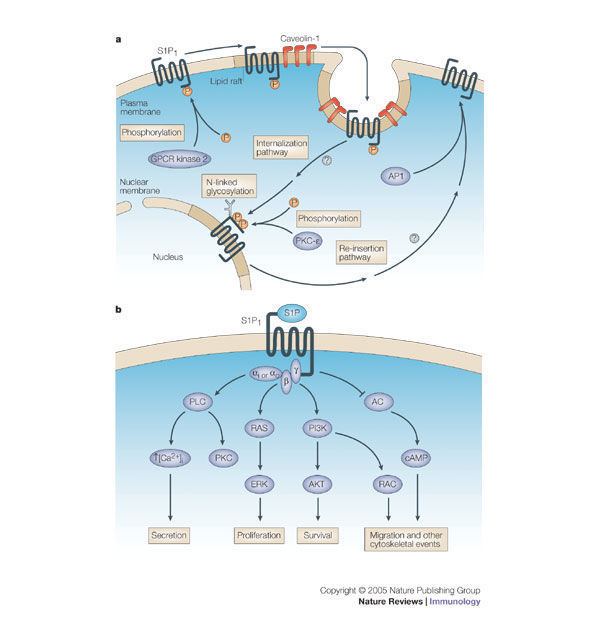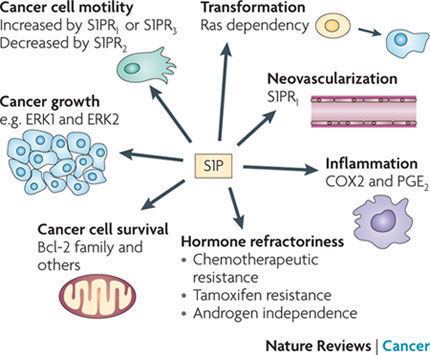Formula C18H38NO5P | ||
 | ||
Gene music using protein sequence of s1pr2 sphingosine 1 phosphate receptor 2
Sphingosine-1-phosphate (S1P) is a signaling sphingolipid, also known as lysosphingolipid. It is also referred to as a bioactive lipid mediator. Sphingolipids at large form a class of lipids characterized by a particular aliphatic aminoalcohol, which is sphingosine.
Contents
- Gene music using protein sequence of s1pr2 sphingosine 1 phosphate receptor 2
- Gene music using protein sequence of s1pr4 sphingosine 1 phosphate receptor 4
- Production
- Metabolism and Degradation
- Function
- Clinical significance
- S1P as a drug
- S1P as a drug target
- S1P receptors as a drug target
- S1P receptor modulators
- References

Gene music using protein sequence of s1pr4 sphingosine 1 phosphate receptor 4
Production

Sphingosine can be released from ceramides, a process catalyzed by the enzyme ceramidase. Phosphorylation of sphingosine is catalyzed by sphingosine kinase, an enzyme ubiquitously found in the cytosol and endoplasmatic reticulum of various types of cells.
Metabolism and Degradation

S1P can be dephosphorylated to sphingosine by sphingosine phosphatases and can be irreversibly degraded by an enzyme, Sphingosine phosphate lyase.
Function

S1P is a blood borne lipid mediator, in particular in association with lipoproteins such as high density lipoprotein (HDL). It is less abundant in tissue fluids. This is referred to as the S1P gradient, which seems to have biological significance in immune cell trafficking.
Originally thought as an intracellular second messenger, it was discovered to be an extracellular ligand for G protein-coupled receptor S1PR1 in 1998. It is now known that S1P receptors are members of the lysophospholipid receptor family. There are five described to date. Most of the biological effects of S1P are mediated by signaling through the cell surface receptors.
Although S1P is of importance in the entire human body, it is a major regulator of vascular and immune systems. In addition, it might be relevant in the skin. In the vascular system, S1P regulates angiogenesis, vascular stability, and permeability. In the immune system, it is now recognized as a major regulator of trafficking of T- and B-cells. S1P interaction with its receptor S1PR1 is needed for the egress of immune cells from the lymphoid organs (such as thymus and lymph nodes) into the lymphatic vessels. Inhibition of S1P receptors was shown to be critical for immunomodulation. S1P has also been shown to directly suppress TLR mediated immune response from T cells.
Clinical significance
The levels of S1P ( in a range of 5-40 µmol/L ) are 5 to 10 times up-regulated in ovarian cancer patients' ascites. S1P at this physiological concentration stimulates migration and invasion of epithelial ovarian cancer cells but inhibits migration of normal ovarian surface epithelial cells. Most (more than 90%) ovarian cancers arise from the epithelium of the ovary. Therefore, extracellular S1P could have an important role in cancer progression by promoting migration of epithelial ovarian cancer cells.
Ozonization of human blood is associated with increased concentrations of S1P in the plasma.
In addition, S1P modulates the proliferation of skin cells. This in particular applies to keratinocytes while fibroblasts are not addressed in this way, apart from cell growth and differentiation While S1P suppresses epidermal proliferation as the glucocorticoids do, it differs from them in so far, as proliferation of dermal fibroblasts is not reduced. In fact, S1P even activates fibroblast-derived extracellular matrix protein production.
S1P as a drug
Administration of S1P has been shown to protect oocytes from chemotherapeutic agents in vitro, as well as in vivo from chemotherapeutic and radiation therapies. which otherwise induce apoptosis of the cells. S1P has protected ovarian tissue xenografts in SCID mouse models from radiation induced atresia. In animal models these protected oocytes have been used to produce healthy live young. Radiotherapies and chemotherapies can cause apoptosis of ovarian follicles, causing premature ovarian failure, and so S1P is of great interest in fertility preservation. However, its mechanism of inhibiting the sphingomyelin apoptotic pathway may also interfere with the apoptosis action of chemotherapy drugs.
Due to the hyperproliferative action against epidermal cells, S1P has been considered as an active pharmaceutical ingredient for hyperproliferative skin diseases, in particular, psoriasis vulgaris and acne vulgaris.
Although S1P is active at very low concentrations, bioavailability of the compound in human skin is a concern. Therefore, a topical formulation based on specific drug carriers has been considered inevitable.
S1P as a drug target
Lpath Inc has produced and optimized a monoclonal anti-S1P antibody (Sphingomab). Sphingomab can absorb S1P from the extracellular fluid, thereby lowering the effective concentration of S1P.
Sonepcizumab is an experimental anti-S1P monoclonal antibody that has had a phase II clinical trial for renal cell carcinoma. Sonepcizumab (LT1009) as ASONEP (for intravenous injection) has been studied for solid tumours. As iSONEP, a formulation for intravitreal injection, it has been studied for age-related macular degeneration.
S1P receptor(s) as a drug target
There are 5 types of Sphingosine-1-phosphate receptor.
S1P receptor modulators
The drug fingolimod (FTY720), which agonizes the S1P receptor, prevents autoimmune lymphocytes from moving from the lymphoid organs into the central nervous system. It has been shown in phase III clinical trials to reduce relapses and improve other outcomes in multiple sclerosis. S1P, as well as FTY720, has been shown to have anti-inflammatory properties at low concentrations and prevent monocyte:endothelial interactions in aorta, possibly through the S1P1 receptor.
ONO-4641 (a drug of Ono Pharmaceutical Co., Ltd.) is a sphingosine-1-phosphate (S1P) receptor agonist which keeps lymphocytes in lymph nodes and thereby inhibits the infiltration of lymphocytes into lesions. The compound is therefore expected to be a drug for the treatment of auto-immune diseases such as multiple sclerosis, which is regarded as an intractable disease.
Ozanimod is an agonist of the S1P1 and S1P5 receptors. and has been studied for various forms of multiple sclerosis.
